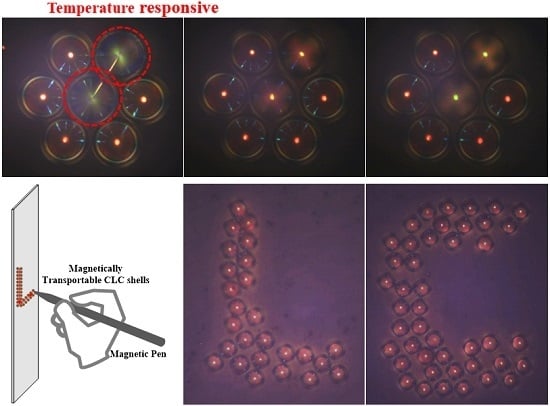Magnetic Nanoparticle-Assisted Tunable Optical Patterns from Spherical Cholesteric Liquid Crystal Bragg Reflectors
Abstract
:1. Introduction
2. Materials and Methods
2.1. Materials
2.2. Fabrication of Cholesteric Liquid Crystal Shells/Droplets
2.3. Optical Characterization
3. Experimental Results and Discussions
3.1. Magnetic Movement of CLC Microshells toward Distance-Dependent Reflections
3.2. Influence of Handedness and Pitch on Tunable Optical Patterns in Close-Packed Hexagonal Arrays with CLC Microdroplets and Microshells by a Magnet
3.3. Magnetic Control of Macroscopical Arrays for Secure Authentication
4. Conclusions
Acknowledgments
Author Contributions
Conflicts of Interest
References
- Neill, M.O.; Kelly, S.M. Photoinduced surface alignment for liquid crystal displays. J. Phys. D Appl. Phys. 2000, 33, 67–84. [Google Scholar] [CrossRef]
- Palto, S.P.; Blinov, L.M.; Barnik, M.I.; Lazarev, V.V.; Umanskii, B.A.; Shtykov, N.M. Photonics of liquid-crystal structures: A review. Crystallogr. Rep. 2011, 56, 622. [Google Scholar] [CrossRef]
- Kumar, M.; Kumar, S. Liquid crystals in photovoltaics: A new generation of organic photovoltaics. Polym. J. 2017, 49, 85–111. [Google Scholar] [CrossRef]
- Mitov, M. Cholesteric liquid crystals in living matter. Soft Matter 2017, 13, 4176–4209. [Google Scholar] [CrossRef] [PubMed]
- Urbanski, M.; Reyes, C.G.; Noh, J.; Sharma, A.; Geng, Y.; Subba Rao Jampani, V.; Lagerwall, J.P. Liquid crystals in micron-scale droplets, shells and fibers. J. Phys. Condens. Matter 2017, 29, 133003. [Google Scholar] [CrossRef] [PubMed]
- Muševič, I. Integrated and topological liquid crystal photonics. Liq. Cryst. 2013, 41, 418–429. [Google Scholar] [CrossRef]
- Li, Y.; Jun-Yan Suen, J.; Prince, E.; Larin, E.M.; Klinkova, A.; Therien-Aubin, H.; Zhu, S.; Yang, B.; Helmy, A.S.; Lavrentovich, O.D.; et al. Colloidal cholesteric liquid crystal in spherical confinement. Nat. Commun. 2016, 7, 12520. [Google Scholar] [CrossRef] [PubMed]
- Li, Y.; Prince, E.; Cho, S.; Salari, A.; Mosaddeghian Golestani, Y.; Lavrentovich, O.D.; Kumacheva, E. Periodic assembly of nanoparticle arrays in disclinations of cholesteric liquid crystals. Proc. Natl. Acad. Sci. USA 2017, 114, 2137–2142. [Google Scholar] [CrossRef] [PubMed]
- Humar, M.; Muševič, I. Surfactant sensing based on whispering-gallery-mode lasing in liquid-crystal microdroplets. Opt. Express 2011, 19, 19836–19844. [Google Scholar] [CrossRef] [PubMed]
- Wang, Y.; Li, H.; Zhao, L.; Liu, Y.; Liu, S.; Yang, J. Tunable whispering gallery modes lasing in dye-doped cholesteric liquid crystal microdroplets. Appl. Phys. Lett. 2016, 109, 231906. [Google Scholar] [CrossRef]
- Uchida, Y.; Takanishi, Y.; Yamamoto, J. Controlled Fabrication and Photonic Structure of Cholesteric Liquid Crystalline Shells. Adv. Mater. 2013, 25, 3234–3237. [Google Scholar] [CrossRef] [PubMed]
- Chen, L.J.; Li, Y.N.; Fan, J.; Bisoyi, H.K.; Weitz, D.A.; Li, Q. Photoresponsive Monodisperse Cholesteric Liquid Crystalline Microshells for Tunable Omnidirectional Lasing Enabled by a Visible Light-Driven Chiral Molecular Switch. Adv. Opt. Mater. 2014, 2, 845–848. [Google Scholar] [CrossRef]
- Chen, L.J.; Gong, L.L.; Lin, Y.L.; Jin, X.Y.; Li, H.Y.; Li, S.S.; Che, K.J.; Cai, Z.P.; Yang, C.Y. Microfluidic fabrication of cholesteric liquid crystal core-shell structures toward magnetically transportable microlasers. Lab. Chip 2016, 16, 1206–1213. [Google Scholar] [CrossRef] [PubMed]
- Lin, Y.L.; Gong, L.L.; Che, K.J.; Li, S.S.; Chu, C.X.; Cai, Z.P.; Yang, C.Y.; Chen, L.J. Competitive excitation and osmotic-pressure-mediated control of lasing modes in cholesteric liquid crystal microshells. Appl. Phys. Lett. 2017, 110, 223301. [Google Scholar] [CrossRef]
- Noh, J.; Liang, H.L.; Drevensek-Olenik, I.; Lagerwall, J.P.F. Tuneable multicoloured patterns from photonic cross-communication between cholesteric liquid crystal droplets. J. Mater. Chem. C 2014, 2, 806–810. [Google Scholar] [CrossRef]
- Fan, J.; Li, Y.; Bisoyi, H.K.; Zola, R.S.; Yang, D.K.; Bunning, T.J.; Weitz, D.A.; Li, Q. Light-directing omnidirectional circularly polarized reflection from liquid-crystal droplets. Angew. Chem. 2015, 54, 2160–2164. [Google Scholar] [CrossRef] [PubMed]
- Abetahoff, S.J.; Sukas, S.; Yamaguchi, T.; Hommersom, C.A.; Le Gac, S.; Katsonis, N. Superstructures of chiral nematic microspheres as all-optical switchable distributors of light. Sci. Rep. 2015, 5, 14183. [Google Scholar] [CrossRef] [PubMed]
- Geng, Y.; Noh, J.; Drevensek-Olenik, I.; Rupp, R.; Lenzini, G.; Lagerwall, J.P. High-fidelity spherical cholesteric liquid crystal Bragg reflectors generating unclonable patterns for secure authentication. Sci. Rep. 2016, 6, 26840. [Google Scholar] [CrossRef] [PubMed]
- Kim, J.G.; Park, S.Y. Photonic Spring-Like Shell Templated from Cholesteric Liquid Crystal Prepared by Microfluidics. Adv. Opt. Mater. 2017, 5, 1700243. [Google Scholar] [CrossRef]
- Seo, H.J.; Lee, S.S.; Noh, J.; Ka, J.W.; Won, J.C.; Park, C.; Kim, S.H.; Kim, Y.H. Robust photonic microparticles comprising cholesteric liquid crystals for anti-forgery materials. J. Mater. Chem. C 2017, 5, 7567–7573. [Google Scholar] [CrossRef]
- Utada, A.S.; Lorenceau, E.; Link, D.R.; Kaplan, P.D.; Stone, H.A.; Weitz, D.A. Monodisperse Double Emulsions Generated from a Microcapillary Device. Science 2005, 308, 537. [Google Scholar] [CrossRef] [PubMed]
- Faryad, M.; Lakhtakia, A. The circular Bragg phenomenon. Adv. Opt. Photonics 2014, 6, 225. [Google Scholar] [CrossRef]
- St. John, W.D.; Fritz, W.J.; Lu, Z.J.; Yang, D.K. Bragg reflection from cholesteric liquid crystals. Phys. Rev. E 1995, 51, 1191–1198. [Google Scholar] [CrossRef]
- Kim, S.H.; Kim, S.H.; Yang, S.M. Patterned Polymeric Domes with 3D and 2D Embedded Colloidal Crystals using Photocurable Emulsion Droplets. Adv. Mater. 2009, 21, 3771–3775. [Google Scholar] [CrossRef]
- Noh, K.G.; Park, S.Y. Smart molecular-spring photonic droplets. Mater. Horiz. 2017, 4, 633–640. [Google Scholar] [CrossRef]
- Tseng, H.F.; Cheng, M.H.; Li, J.W.; Chen, J.T. Solvent On-Film Annealing (SOFA): Morphological Evolution of Polymer Particles on Polymer Films via Solvent Vapor Annealing. Macromolecules 2017, 50, 5114–5121. [Google Scholar] [CrossRef]
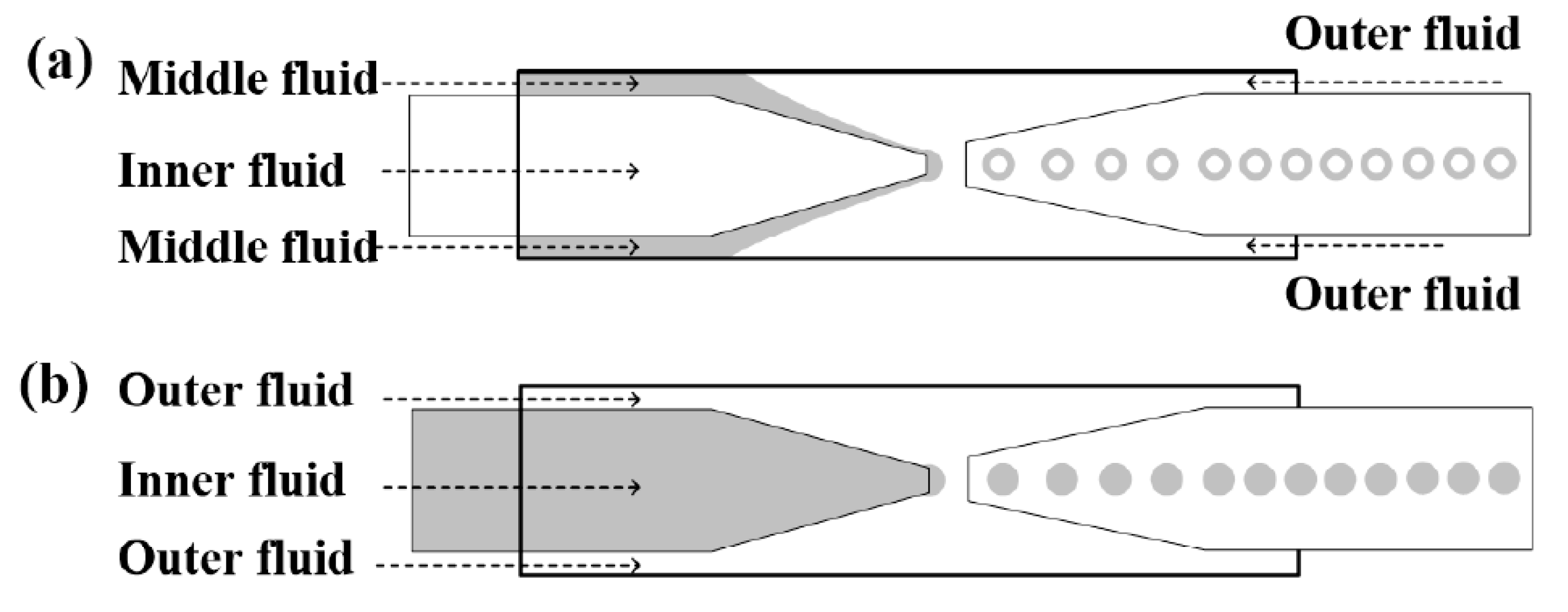

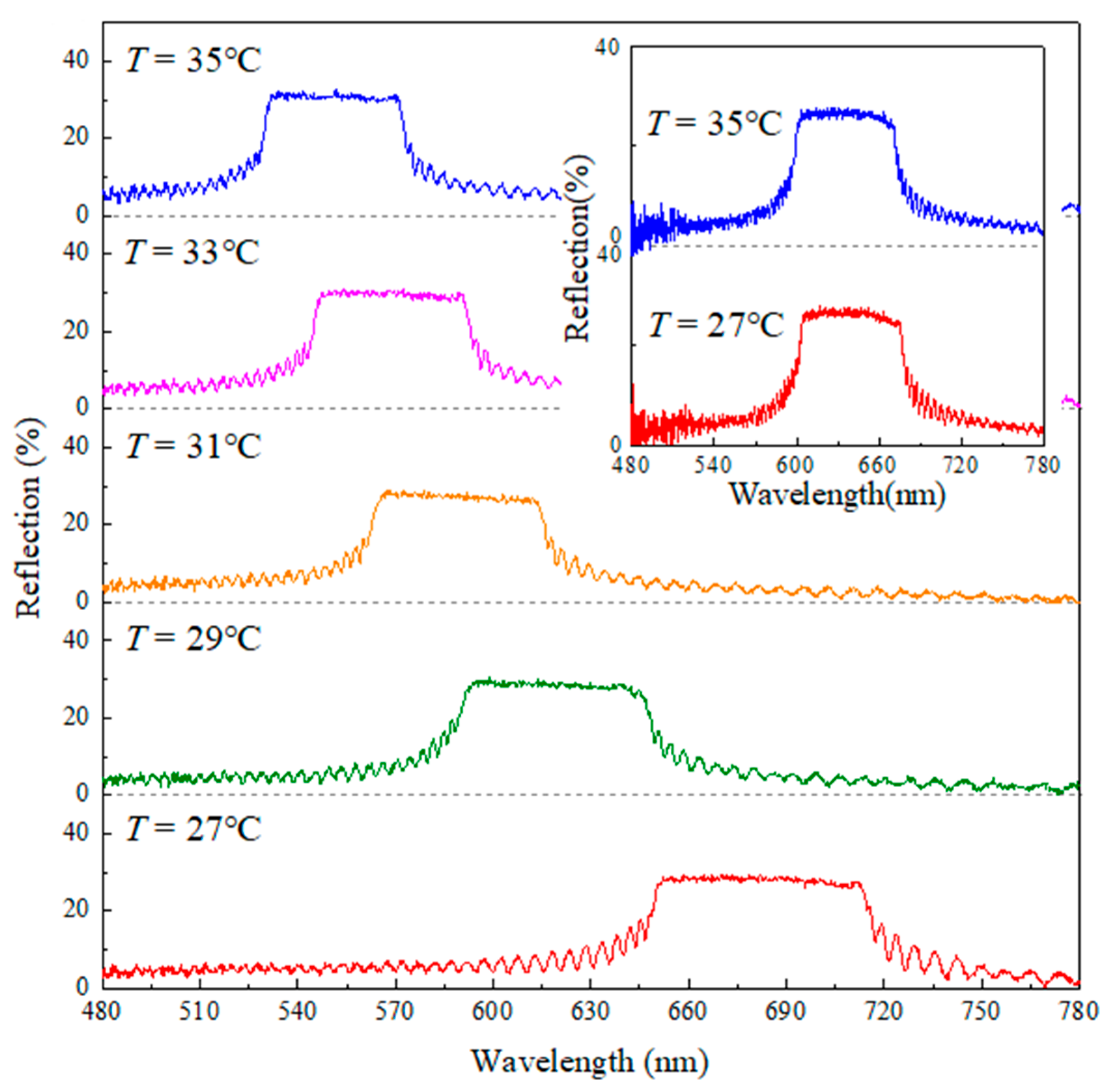
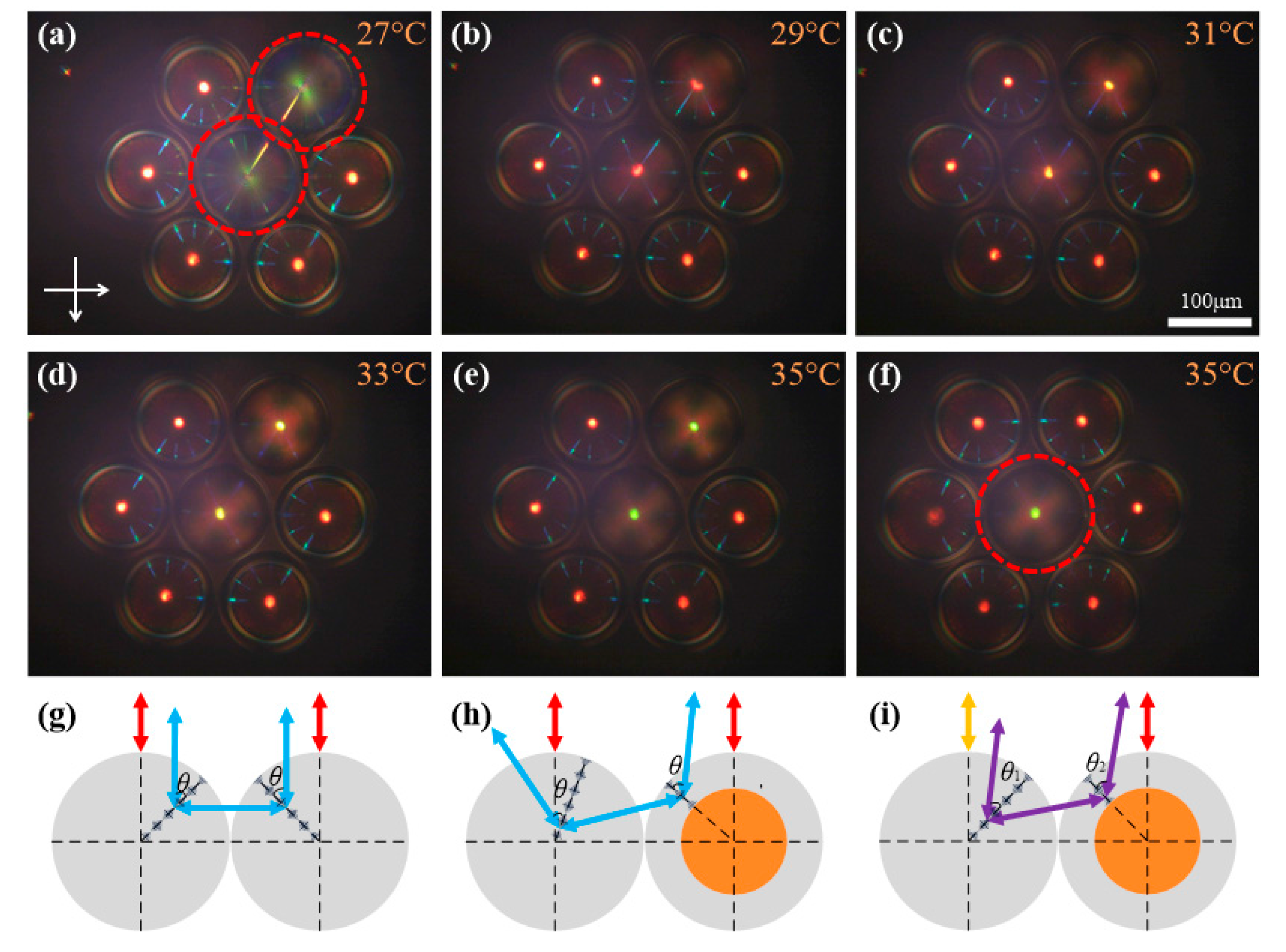
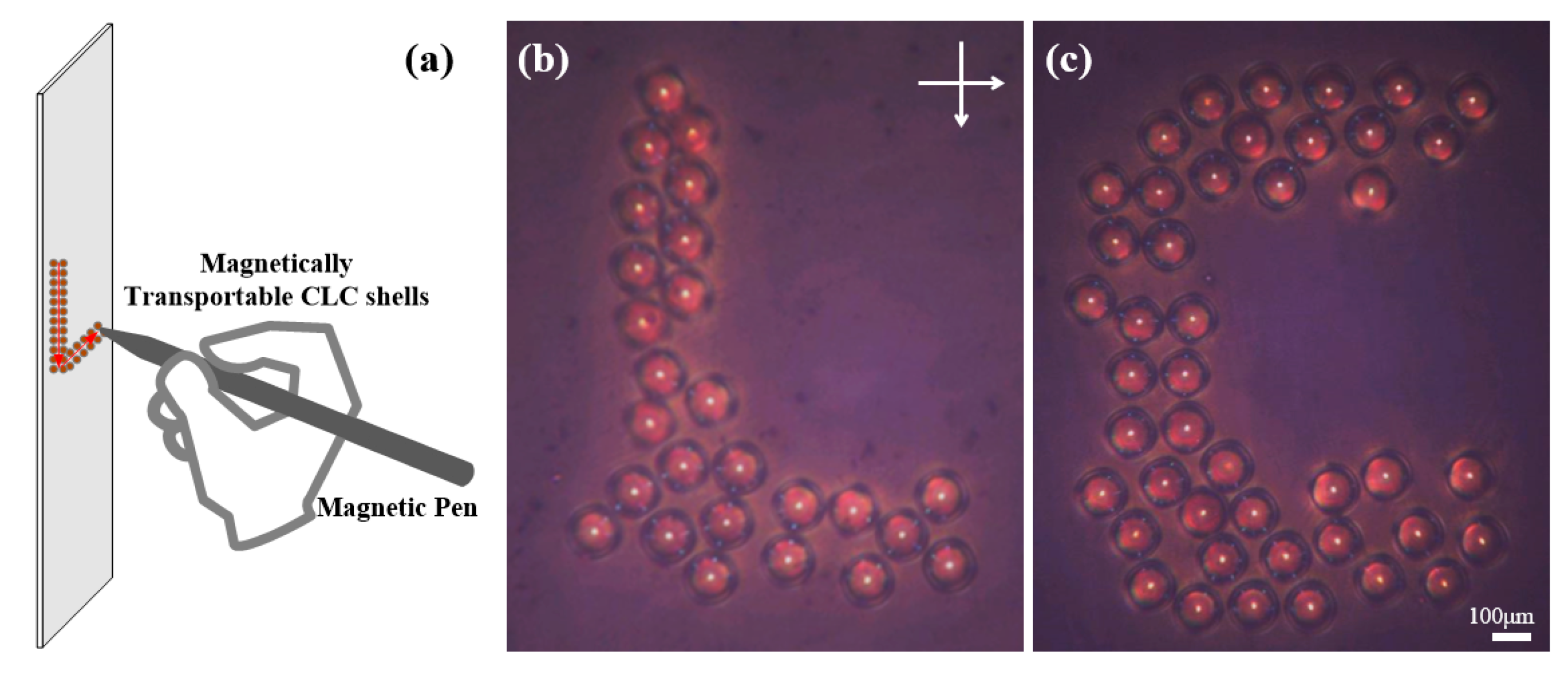
© 2017 by the authors. Licensee MDPI, Basel, Switzerland. This article is an open access article distributed under the terms and conditions of the Creative Commons Attribution (CC BY) license (http://creativecommons.org/licenses/by/4.0/).
Share and Cite
Lin, Y.; Yang, Y.; Shan, Y.; Gong, L.; Chen, J.; Li, S.; Chen, L. Magnetic Nanoparticle-Assisted Tunable Optical Patterns from Spherical Cholesteric Liquid Crystal Bragg Reflectors. Nanomaterials 2017, 7, 376. https://doi.org/10.3390/nano7110376
Lin Y, Yang Y, Shan Y, Gong L, Chen J, Li S, Chen L. Magnetic Nanoparticle-Assisted Tunable Optical Patterns from Spherical Cholesteric Liquid Crystal Bragg Reflectors. Nanomaterials. 2017; 7(11):376. https://doi.org/10.3390/nano7110376
Chicago/Turabian StyleLin, Yali, Yujie Yang, Yuwei Shan, Lingli Gong, Jingzhi Chen, Sensen Li, and Lujian Chen. 2017. "Magnetic Nanoparticle-Assisted Tunable Optical Patterns from Spherical Cholesteric Liquid Crystal Bragg Reflectors" Nanomaterials 7, no. 11: 376. https://doi.org/10.3390/nano7110376



